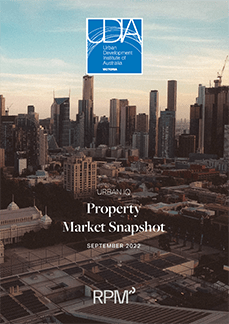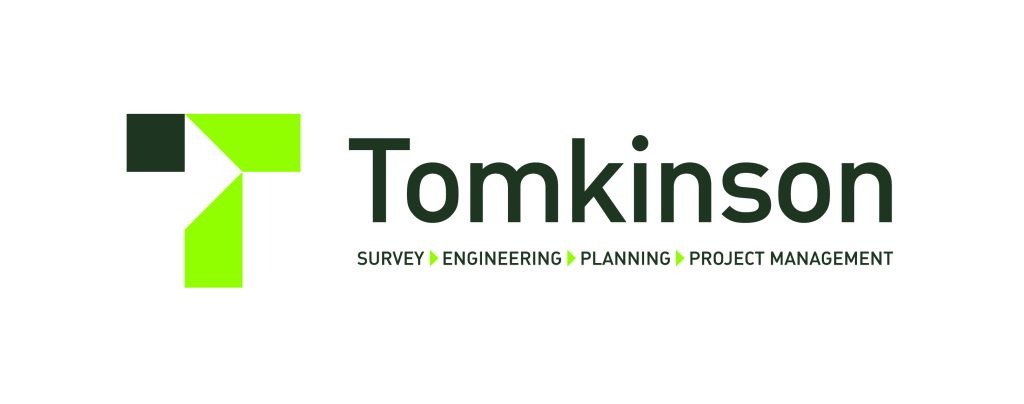
UDIA Victoria, in partnership with RPM Group, has released the latest quarterly URBAN IQ research publication.
The research provides data, research and analysis to help our members understand the conditions in which we are operating.
Read the full URBAN IQ Q2 2022, in English
Summary of Key Findings
Economic Overview
- Gross Domestic Product
% Change: Australia’s GDP increased 0.89% in Q2 2022, leading to 3.88% annual growth.
This remains above the long-term average. - Household Savings Ratio
Household Savings Ratio remains elevated at 8.7% but increasing cost of living pressures are leaving an impact. - Household Consumption
Services expenditure rose 3.6% underpinned by latent spending in sectors impacted by mobility restrictions. - Interest Rates
The RBA has now increased the cash rate by 225 basis points in just 5 months. This marks the most rapid increases observed since 1994.
This is in response to persisting inflation, which has jumped 6.14% year on year. - CPI and the New Dwelling Index
6.14% = Australian CPI Q2 Y.O.Y
5.6% = CPI Index for New Dwellings Q2 2022
0.71% = CPI Index for Rents Q2 2022 - Labour Markets
Employment remains a bright spot in Victoria, with the state adding 22,600 full time jobs in Q2 2022, or 64% of all job creation nationally. - Wages vs. CPI
The tight employment market is starting to initiate higher wage growth; however, this still remains below CPI. - Market Sentiment
Consumer sentiment has continued to deteriorate since our last reading in April (90.4) to now sit at 81.2.
High inflation the increasing cash rate and subsequent borrowing rate rises are key contributors. - NAB Business Conditions Index
Businesses have remained optimistic through 2022. Record capacity utilisation and price rises have driven growth in the sub categories of trading, profitability, and employment. - Victorian Population
Victoria’s population increased by 13,471 in Q4 2021 (latest available data), the first increase observed since June 2020.
Latest Australia Government projections released in April 2022 forecast a return to population growth of +65,300 over 2022-23, before returning to pre-pandemic levels from 2023-2024. - Active Estates
The most recent increase in active estates has occurred in the Northern and Geelong growth areas. - Lot Supply
Despite active estates increasing, new lot supply during the three months to August 2022 diminished, compared to the previous three months. This is likely attributed to lower levels of absorption, with the 4,085 lot releases still being 21% above lot sales. - Lot Sales
The combined growth areas experienced a pull forward in demand in 2021, creating a vacuum in demand. This is exacerbated by cost-of-living pressures, and high construction costs. - Lot Price Change
While annual lot price growth rates remain significant, median lot prices across the growth areas are now stabilising, with higher interest rates and construction costs leading to affordability concerns intensifying - Lot Sizes
New home demand has shifted markedly through 2022, with buyers increasingly favouring smaller lots to compensate for higher build costs and increased borrowing repayments - Melbourne Residential Market
Purchasers are becoming increasingly cautionary, as ongoing interest rate rises take their toll.
$1,081,000 = Median House Price
-2.9% change from Q1 2022
+6.8% from Q2 2021
$670,500 = Median Unit Price
-1.3% change from Q1 2022
-1.1% from Q2 2021
$379,000 = Median Lot Price
+3.6% change from Q1 2022
+19.2% from Q2 2021
Building Activity
- Victoria Building and Finance Activity
The total value of new owner occupier loans (excluding refinancing) increased by 3.9% over the quarter but is down 9% year-on-year.
29,969 = Total Owner Occupier Loan Approvals +4% vs. last quarter
$502,629 = Average FHB loan size (+0.8%) - Townhome Activity
12,814 townhome approvals were recorded in the 12 months to Q2.
Up 8% year on year. - Approvals and Commencements
Victorian dwelling approvals were down 3.2% in Q2 to 14,932 with the fall in detached house approvals the greatest contributor. This reflects a return to pre-HomeBuilder levels. - Commencements
House commencements have increased to a record 40,060 over 2020-21 on the back of extremely strong lot sales activity through the HomeBuilder period. Due to this pull forward in demand, commencements are anticipated to soften in 2022-23. - Growth Area Affordability
Historically, the common benchmark for identifying housing stress in Australia has been identified as those that allocate at least 30% of disposable household income to finance their mortgage. This ratio has been in place for decades but recently, there is a growing view that the ratio should be closer to 35% to 40% to reflect today’s market.
Overall, just 16 suburbs recorded a mortgage to household income ratio of below 35%. Up from 10 last quarter, 22 suburbs recorded a mortgage to household income ratio from 35% to 39%, with this level being synonymous with the emergence of constrained affordability. Many of these suburbs are established development fronts with low stock levels, allowing estates to push up prices.
Outlook
TAILWINDS
- Removal of lockdowns and restrictions with total boarders opened
Net overseas migration is a key driver of economic growth. Its return will boost economic activity and alleviate staff shortages currently experienced across industries. - Tight labour market to underpin wage growth
Low unemployment (currently 3.4% nationally at July-22), is expected to persist, with anticipated wage growth somewhat offsetting stronger inflation and interest rate rises. - Considerable pipeline of residential construction projects
The success of homebuilder and the record-breaking year that was 2021 will continue to feed public and private dwelling investment. - Australian energy to benefit
Australia is set to post larger energy revenues as a result of the conflict in Eastern Europe.
HEADWINDS
- Ongoing conflict in Eastern Europe
May exacerbate supply chain issues, resulting in further inflationary pressures, particularly on oil. - Expectation for inflation to peak later in 2022
Continued reduction in buyer capacity and household expenditure. - Ongoing risk of further COVID-19 variants

The Urban IQ Property Market reports are produced for UDIA Victoria by RPM Group.
The reports provide a quarterly update on the Victorian residential market including economic activity, prices, finance, building, sentiment and affordability metrics.










